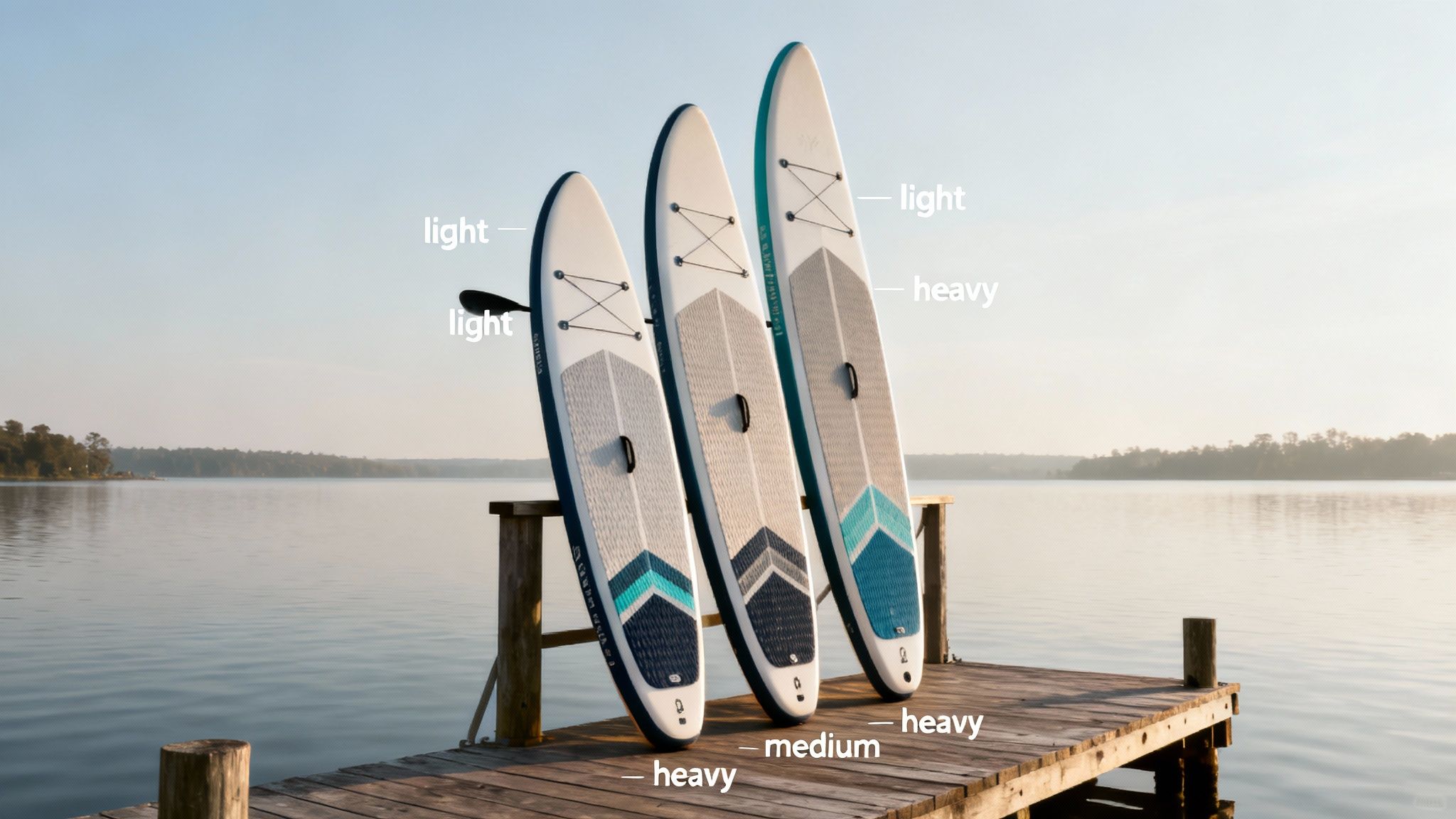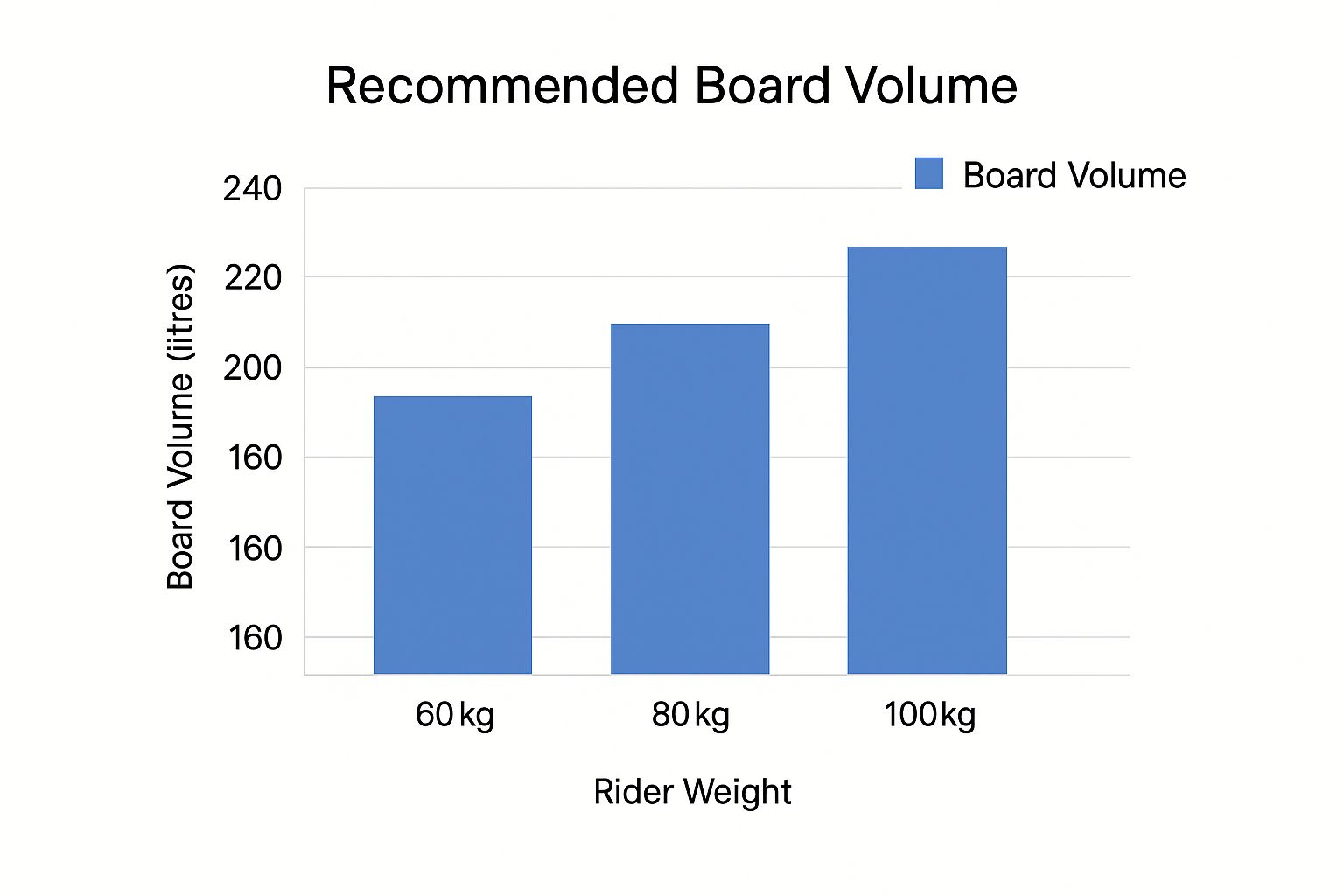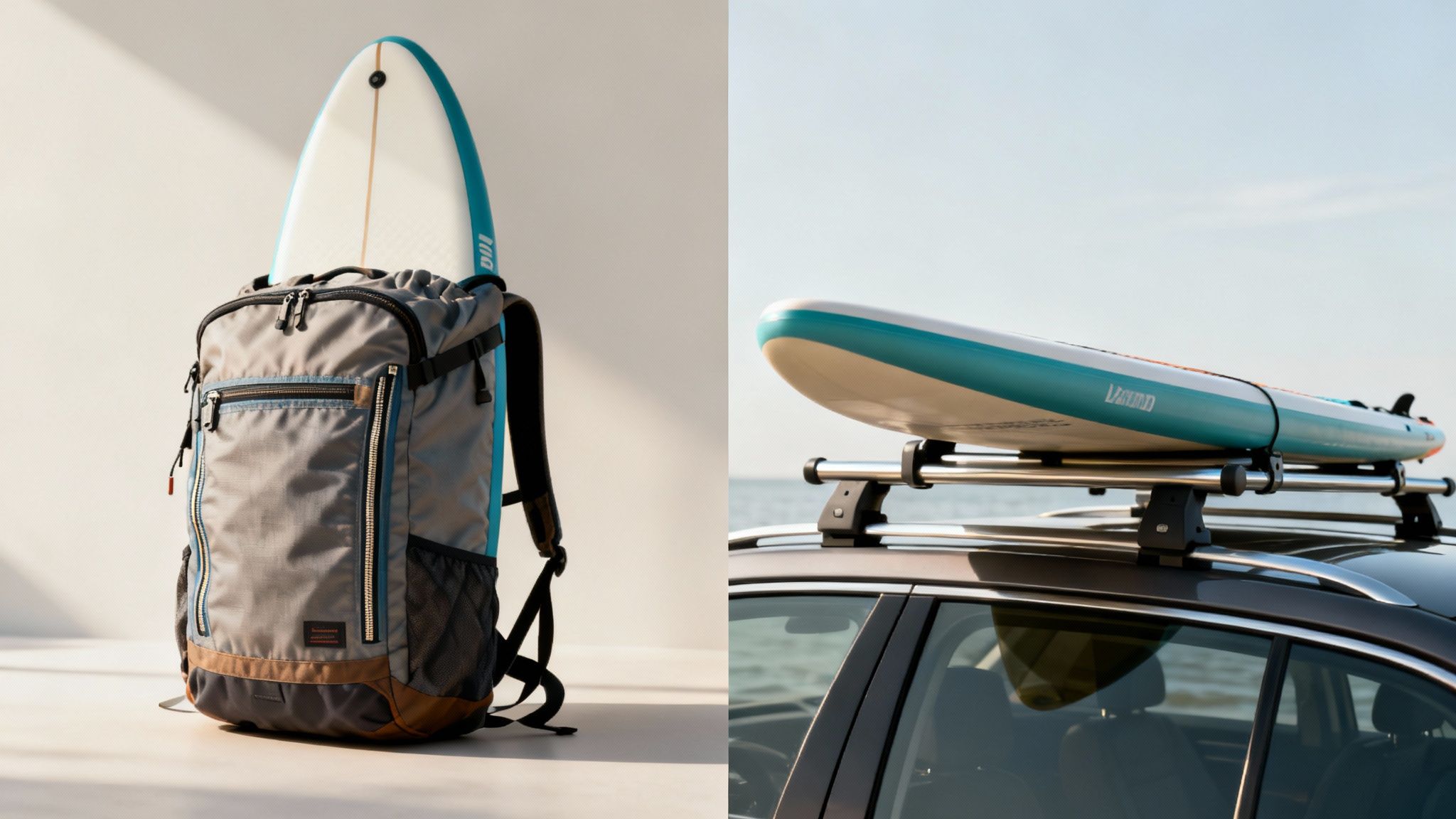What Size SUP Board Do I Need? A Complete Guide

Picking the right stand-up paddle board isn't rocket science. It really just comes down to three things: your weight, your skill level, and what you actually want to do with it.
If you're just starting out here in the UK, the best bet is almost always a stable, versatile 'all-around' board. Think of it as the reliable family car of the SUP world—it’s dependable, forgiving, and ready for pretty much anything you can throw at it. For example, a board like our Loco Amigo All-Round SUP is designed to be user-friendly, making it perfect for your first paddles on a calm lake or a gentle coastal cruise.
Your Quick Guide to Choosing the Right SUP Size

The first step to finding your perfect board is matching its volume and dimensions to your body weight. Getting this right is crucial because it ensures the board has enough buoyancy to support you properly. A board that's too small for you will feel wobbly and unstable, which is no fun for anyone. For instance, a 95kg person trying to use a board designed for a 60kg rider will likely spend more time in the water than on it.
Across the British Isles, the go-to board for most recreational paddlers is an all-arounder, usually somewhere between 10 and 11 feet long and 32 to 34 inches wide. This size bracket offers a brilliant blend of stability and glide. If you're curious about the broader market trends, the folks at imarcgroup.com have some interesting insights.
To get you started with confidence, have a look at the simple guide below. It's a great starting point for answering that common question, "what size SUP board do I need?".
Quick SUP Size Guide By Rider Weight
This table gives you a straightforward match between your weight and the board specs you should be looking for. Think of this as your baseline before we dive into the nitty-gritty of length, width, and thickness in the next sections.
| Rider Weight (kg) | Recommended Volume (Litres) | Typical All-Around Board Size (Length x Width) | A Good Loco SUP Example |
|---|---|---|---|
| Under 55 kg | 130 - 150 L | 9'6" x 30" | Loco 9'5'' Amigo Air |
| 55 - 70 kg | 150 - 190 L | 10'0" x 31" | Loco 10' Amigo Air |
| 70 - 85 kg | 190 - 240 L | 10'6" x 32" | Loco 10'6'' Amigo Air |
| 85 - 100 kg | 240 - 280 L | 10'8" x 33" | Loco 10'8'' Motion Air |
| 100 - 115 kg | 280 - 320 L | 11'0" x 34" | Loco 11' Voyage Air |
| Over 115 kg | 320+ L | 11'6" x 35" | Loco 12'6'' Voyage or Discovery Air |
Once you've found your row in the table, you have a solid foundation. Now, we can start looking at how different activities—like touring, yoga, or surfing—might change the ideal shape and size for you.
Right then, let's get to the heart of what makes a SUP board right for you. Forget all the marketing jargon for a moment; it all boils down to three key ingredients: volume, length, and width. Get these right, and you're well on your way to finding the perfect board.
First up is volume, which we measure in litres. Think of it simply as your board's buoyancy or 'floating power'. It’s the single most important factor that dictates how much weight a board can comfortably support. More volume means more float, which translates directly to a more stable, forgiving ride, especially when you're just starting out. For example, a 240L board will feel much steadier under a beginner's feet than a 180L board of the same length and width.
Next, we have length. This is all about how the board moves through the water. A longer board will track straighter and glide further with each paddle stroke, a bit like a touring kayak. This makes them brilliant for covering distance. Shorter boards, on the other hand, are the sports cars of the SUP world – nimble, responsive, and perfect for quick, sharp turns, especially in the surf. A 12'6" board like the Loco Voyage is ideal for exploring a long stretch of coastline, while an 8' surf SUP is what you'd want for playing in the waves at Fistral Beach.
Finally, there's width, your foundation for stability. A wider board gives you a much more solid, dependable platform under your feet, which is a massive confidence booster for beginners. A great example is the super-stable 32" or 33" width of the Loco Amigo All-Round SUP, which is built to be forgiving. Contrast that with a sleek, 28" narrow race board that's all about slicing through the water for speed, and you can see how width creates a completely different experience on the water.
Matching Board Volume to Your Weight and Skill
When people ask, "what size SUP board do I need?", the first and most important number to look at is volume. Think of volume, measured in litres (L), as the board's total buoyancy. It's what dictates how stable you'll feel on the water.
As a rule of thumb for beginners, take your weight in kilograms and add between 100 and 140. The result is a great starting point for the volume you need in a board. This simple calculation ensures the board has more than enough float to keep you steady.
For example, if you weigh 80kg, you’ll want to be looking at boards in the 180-220L range. Our 10'6" Amigo Air, at 220L, is a perfect practical example of this. This volume gives you a really secure, planted platform and helps you avoid that wobbly, unstable feeling that can knock your confidence when you're just starting out. As you get better, you can start looking at boards with less volume, which often trade some of that rock-solid stability for better performance and manoeuvrability.
If you're a heavier paddler, getting this right is even more crucial. We've put together a dedicated SUP board guide for overweight riders that offers more specific advice.
The infographic below gives a quick visual guide to how your weight corresponds to the board volume you should be looking for.

As you can see, the required volume scales up directly with your weight. It's all about making sure the board can comfortably support you.
Recommended SUP Volume By Weight And Skill Level
To give you an even clearer picture, we've broken down the numbers by skill level. You'll notice that as paddlers become more advanced, they can handle boards with significantly less volume because their balance and technique have improved.
| Rider Weight (kg) | Beginner Volume (Litres) | Intermediate Volume (Litres) | Advanced Volume (Litres) |
|---|---|---|---|
| 50 - 60 | 150 - 170 | 110 - 130 | 90 - 110 |
| 60 - 70 | 170 - 190 | 130 - 150 | 110 - 125 |
| 70 - 80 | 190 - 220 | 150 - 170 | 125 - 140 |
| 80 - 90 | 220 - 240 | 170 - 190 | 140 - 155 |
| 90 - 100 | 240 - 270 | 190 - 210 | 155 - 170 |
| 100+ | 270+ | 210+ | 170+ |
This table is a fantastic reference point. For a beginner, sticking to the higher volume range is your ticket to a more enjoyable and less frustrating learning curve.
How Your Paddling Style Shapes Your Board Choice
So, what’s your paddle boarding dream? Where do you see yourself paddling? The answer to this question completely changes the game when it comes to figuring out "what size SUP board do I need?".
Sure, a versatile all-rounder like the Loco Amigo is a fantastic choice if you want to dip your toes into a bit of everything. But once you get the bug for a specific discipline, you'll soon realise that specialised activities demand specialised gear.
Touring, Surfing, and Yoga Boards
Think of it like choosing a bike. You wouldn't take a skinny road bike down a rugged mountain trail, would you? The same logic applies here.
For those long-distance touring adventures, you’ll want a board that glides effortlessly. That means a long, narrow board, typically between 11'6" and 14', with a sharp, pointed nose designed to slice through the water with maximum efficiency. A practical example is using a Loco 12'6" Voyage touring board to paddle the length of Loch Lomond.
If catching waves is more your scene, you need something completely different. A short, nimble surf SUP (usually under 10') with a bit more curve, or 'rocker', will let you carve and turn on a wave face with ease. Our Loco El Diablo hard surf SUP is a perfect example of a high-performance shape for experienced wave riders.
And for the SUP yoga enthusiasts? It’s all about creating a solid, floating yoga mat. Stability is everything, which makes a wide, stable platform (33"+ in width) an absolute non-negotiable. Look for a board with a large, comfortable deck pad, like our versatile Loco Motion Air, which offers plenty of space and stability for poses.
Of course, the board is only half of the equation. You'll also want to make sure you have the perfect SUP paddle length to complete your setup and get the most out of every stroke. Each design choice, from nose shape to width, directly translates to how the board feels and performs on the water.
Why Board Thickness and Construction Matter
When you're figuring out what size SUP board you need, it's easy to focus just on length and width. But let me tell you, thickness is a massive, and often overlooked, part of the puzzle. For most adults jumping on an inflatable board, I'd say a 6-inch thickness is absolutely non-negotiable if you want decent rigidity and performance.
Why am I so insistent on this? Well, a thinner board, especially if you weigh over 75kg, is going to sag in the middle under your weight. We call this the dreaded ‘banana effect’, and it’s a real drag—literally. It makes the board feel slow, horribly unstable, and just plain frustrating to paddle. A 6-inch thick board, on the other hand, gives you that crucial stiffness for a responsive, solid feel underfoot, much closer to what you'd expect from a hardboard. For instance, a 90kg paddler on a 4.75" thick board will notice a significant flex, whereas on one of our 6" thick boards, the platform will feel incredibly rigid.
It’s not just about thickness, though; what the board is made of is just as important. Take our Loco inflatable range, for instance. We use a fusion-layered PVC construction. It’s a modern technique that delivers brilliant rigidity without piling on unnecessary weight, making sure you get a high-performance ride every time. Hardboards are a different beast entirely, often built from materials like epoxy or carbon fibre. They offer unmatched stiffness and glide but, of course, you'll need a garage to store one. Getting to grips with these materials is the key to deciding between the pure convenience of an inflatable and the raw performance of a solid board.
Choosing Between Inflatable and Hardboards

The age-old inflatable versus hardboard debate really boils down to one thing: practicality versus performance. It’s the first big decision you’ll make.
Inflatable SUPs, like our ever-popular Loco Motion Air, are the undisputed champs when it comes to convenience. They pack down into a backpack, slide easily into a car boot, and won't take over your garage. For most people, this is a massive win. A great example is being able to take your board on a train to the Lake District, which is something you simply can't do with a hardboard.
On the other hand, you have hardboards. Nothing beats them for pure performance. Their rigid construction delivers a feeling of speed, glide, and responsiveness that inflatables just can't match. This makes them the go-to for serious racers and SUP surfers who need every ounce of performance they can get. The trade-off? You’ll need a roof rack and a proper place to store it.
What If The Board Is For The Whole Family?
This is a common question, and the answer is refreshingly simple.
When buying a board for multiple people, always size it for the heaviest user. A stable, high-volume all-rounder (something like a 10'6" x 32" Loco Amigo) ensures everyone from the kids to the adults can get on the water and have a brilliant, safe time.
Getting this choice right is a huge part of the puzzle. If you're leaning towards an inflatable, our inflatable paddle board buyer's guide dives into even more detail to help you nail your decision.
Still Got Questions About SUP Sizing?
It's completely normal to have a few lingering questions when you're trying to pin down the perfect board size. We get asked a lot about this, so we've pulled together some of the most common queries to help you clear up any final bits of confusion.
One of the big ones is what to do if you’re stuck between two sizes. A simple rule of thumb? Always go for the slightly larger board.
That little bit of extra volume will give you a much more stable platform, which is a massive help when you're just starting out or if you're paddling in the typically choppy waters we get around the UK. For example, if you weigh 85kg and you're choosing between a 10'6" and a 10'8" board, the 10'8" will provide that extra bit of stability and also allow you to carry a child or a dog without compromising performance.





Leave a comment